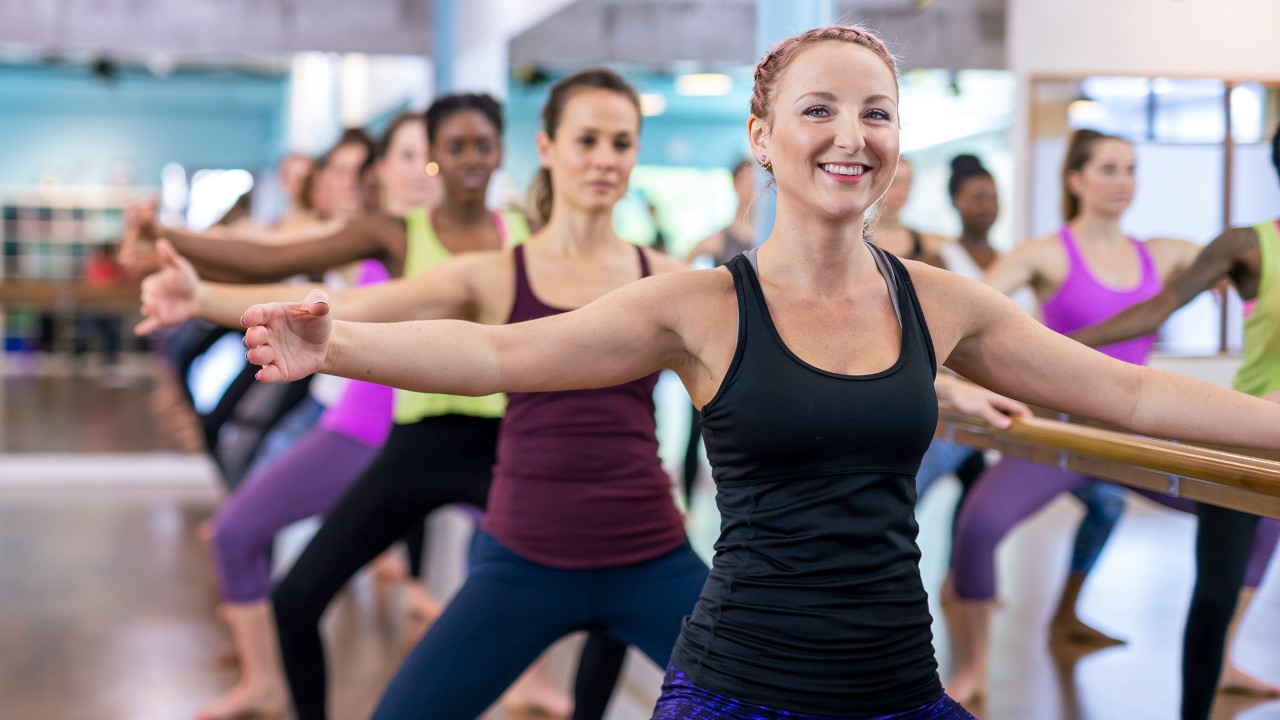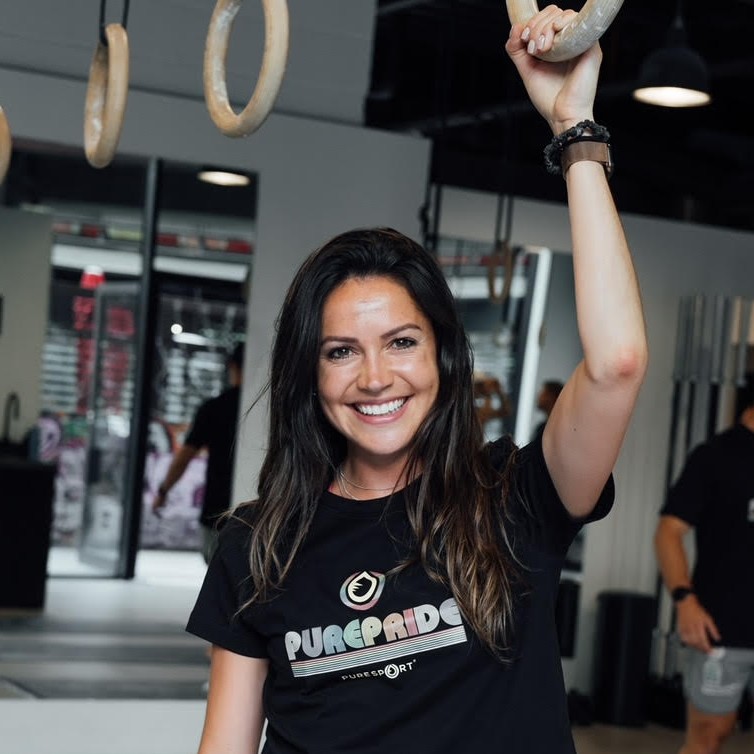This Home Ballet Workout Strengthens Your Inner Thighs
Challenge your legs and core with this beginner ballet workout, which uses pliés to wake up underused muscles and improve your flexibility

Most home legs workouts use a combination of squats and lunges, and there’s nothing wrong with that, but a good home legs workout routine will throw in a fresh challenge every once in a while to stop your exercise becoming one-dimensional. For instance, you could swap squats for pliés, the movement that features in this ballet workout from Sarah Aspinall, ballet teacher and founder of Breaking Ballet.
A plié is similar to a squat, but your legs are turned out at the hip. That way it targets muscles in your legs and glutes that aren’t worked as hard in regular squats, especially your inner thighs (although the sumo squat variation is one of our favourite inner thigh exercises).
“Pliés also offer the added bonus of opening up your hips and helping to improve your range of movement,” says Aspinall. “It’s a beginner-friendly exercise that also improves core stability, posture and flexibility. The turned-out position from the hip also creates an imbalance that forces you to adapt your position in order to not fall over, which helps to improve balance.”
And as Aspinall pointed out to us, working on range of motion and flexibility are things men are often guilty of neglecting.
For this ballet-inspired workout, Aspinall has programmed a series of floor-based and standing movements. “Focus on engaging your inner thighs throughout this workout,” says Aspinall, “and especially before you stand up and complete your plié workout – you are going to find your ballet muscles on the mat.”
To help you get to grips with the plié, watch this plié workout from Aspinall’s YouTube channel, then read on for an exclusive session Aspinall shared with Coach.
Home Ballet Workout Section 1: Floor Movements
Complete the first four moves lying on your right side, then return to the start and complete them all on your left side.
Sign up for workout ideas, training advice, reviews of the latest gear and more.
1 Leg lift
Reps 16
Lie on your right side with your elbow under your shoulder, ensuring you don’t let your shoulder slouch. Bend your left leg and place your foot on the floor behind your right leg so your knee is pointing at the ceiling. Your right leg should be extended. Lift and lower your right leg, leading the movement with your heel. Concentrate on using your inner thigh to move your leg.
2 L-shape
Reps 16
Staying in the same position, repeat the lift and lower with your right leg, but between lifts, move your leg forwards as though you are drawing an L with your big toe. Each L-shape is one rep.
3 Leg lift pulse
Reps 16
The final exercise in this position is a pulse at the top of the leg lift. Try to pulse your leg as high as you can without sitting back on your bottom.
4 Leg squeeze
Reps 16
Lie on your right side with your right arm extended and on the floor, resting your head on your arm. You can place your left hand on the floor in front of you for balance. Lift your left leg as high as you can, then lift your right leg to meet the left. Engage your inner thigh muscles to draw the lower leg towards the top leg. Focus on keeping your top leg in a raised position to get the most out of this exercise.
Remember to return to the start and repeat these four movements on the other side.
5 Lying plié
Reps 16
Lie on your back with your legs extended and pointing at the ceiling. Flex your feet and then rotate your legs out at the hip so your heels are together and your toes are pointing to the sides. Keeping your legs extended, lower them until they’re at 45°; if you feel the small of your back lifting off the floor, lift your legs a little higher. Keeping your heels together, bend your knees to create a diamond shape between your legs. As you straighten your legs, squeeze your inner thighs together.
Home Ballet Workout Section 2: Standing Movements
Remember to use your inner thighs throughout this workout and keep your tailbone pointing down towards your heels for the standing pliés.
“If you experience any discomfort in your knees, check you are tracking your knees over your middle toes and take a shallower bend in your knees if necessary,” says Aspinall. “This isn’t cheating – it’s working out smarter.”
6 Standing plié pulse
Reps 16
Stand with your feet shoulder-width apart. Point your toes around 45° (if you can go wider that’s great, but be careful). Hold your arms out to the sides at shoulder height (this is called second position) and engage your core. Bend your knees, ensuring your knees are tracking over your second and third toes, and keep your back straight. Staying down in your plié, pulse up and down just one inch. Each pulse is one rep. The smaller you keep this movement, the bigger the burn!
7 Plié pulse with heel lift
Reps 16 each side
Staying down in your plié, raise your right heel and continue to pulse up and down. Try to stay as low as you can in your plié without sticking your bottom out. Keep your tailbone pointing down between your heels.
8 Plié pulse with alternating heel lift
Reps 8 each side
Staying down in your plié, raise your right heel and as you pulse up and down, and alternate from one heel to the other. Your weight should remain in the centre (don’t transfer your weight over one leg or the other) and your plié should be as deep as you can take it while maintaining good posture.
9 Plié hold with heel lift
Time 16sec
Time to test your balance. Stay in your plié and raise your heels off the floor so you are balancing on the balls of your feet and remain there for a count of 16. Keep your knees pointing over your middle toes and engage your core. Don’t forget to breathe!
10 Plié pulse with heel lift
Reps 16
Remain in the same position with your heels off the floor and very carefully pulse your knees as you did in the second exercise. This is quite challenging now you have your heels off the floor so, if necessary, hold the back of a chair to begin with while you are improving your balance. Remember, keep your core pulled in tight and focus your eyeline to help with your balance.

Lucy is an experienced health and fitness journalist, and was formerly health editor for TI Media’s portfolio of women’s titles. Lucy qualified as a level 3 personal trainer with Train Fitness in 2016, and also holds qualifications in pre- and post-natal fitness, as well as in nutrition for exercise.
